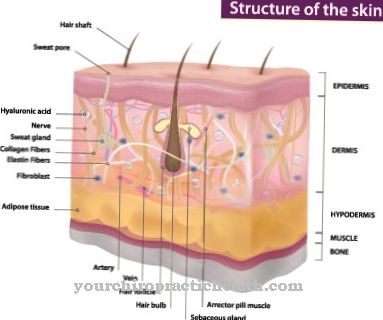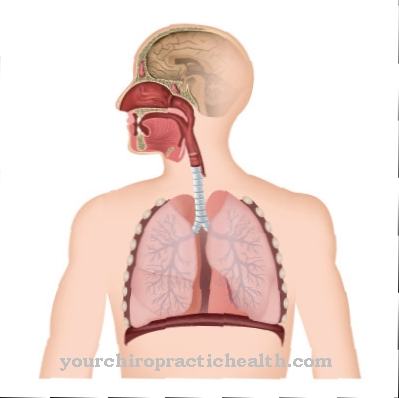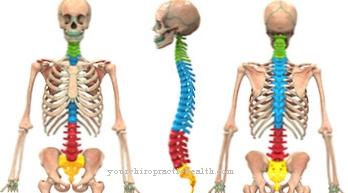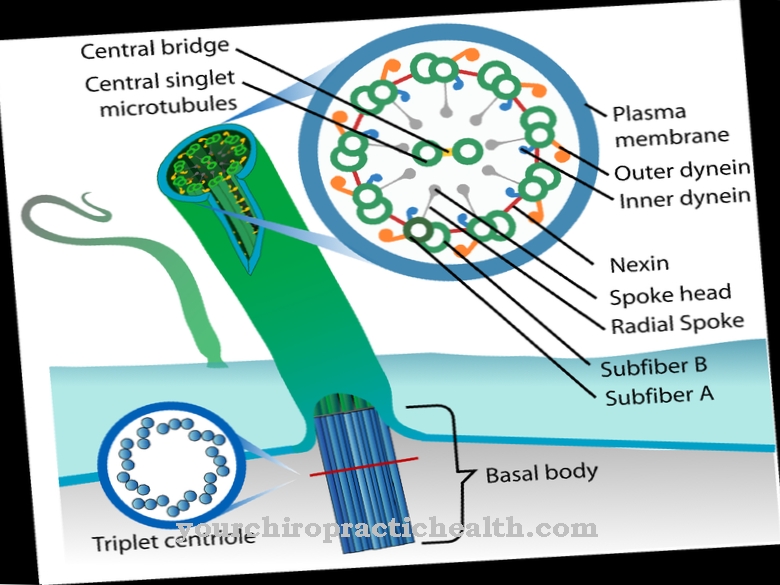Of the Brachycephalus represents a deformation of the skull caused by premature ossification of the coronal suture. The head appears round due to its shortness and width. Since the brain is restricted in its growth by this deformation of the skull, the brachycephalus must be treated surgically at an early stage.
What is Brachycephalus?

© Reinhard Tiburzy - stock.adobe.com
The term brachycephalus comes from the Greek and means "round-headed" or "short-headed". The term can also be synonymous with this designation Brachycephaly be used. The cause is uneven growth of the skull due to premature closure of the coronary suture.
Several head shapes are distinguished within the normal population. These are long skull (dolichocephalus), middle skull (mesocephalus) and short skull (brachycephalus). If these skull shapes are extremely pronounced, there is a pathological disorder of the skull growth. In anthropology, the shapes of the skull play a major role in determining ancestry.
The Karolyi measuring method has established itself. This measurement, also known as the skull index or cranial index, determines the ratio of the greatest head width to the greatest head length. The resulting length-width index ranges from 70/75 for a long skull to 80/85 for a short skull. If this index range is left, pathological skull deformations are present.
causes
The cause of a brachycephalus is the premature ossification of the coronal suture. The peripheral suture, also called coronary suture, is a connective tissue-like suture between the front part of the skull (os frontale) and the two rear parts of the skullcap (ossa parietalia). Usually the ossification of the sutures begins in the second year of life and usually ends between the sixth and eighth year of life.
However, if the coronary suture closes prematurely, the skull will stop growing in length. To compensate for this, the skull then often increases in height, which leads to the formation of a so-called tower skull (turricephalus). Premature suture closure is also known as craniostenosis.
Brachycephalus is just one form of craniostenosis. In many cases, the causes of craniostenoses are not known. They can occur, among other things, in the context of genetic diseases such as Apert syndrome or Crouzon's disease. Often they appear in isolation as the only symptom.
In these cases intrauterine developmental disorders play a role. Even with disorders of the bone metabolism, premature suture closure and thus craniostenosis can occur. It was also established that smoking during pregnancy can lead to undesirable developments.
Symptoms, ailments & signs
The symptoms depend on the severity of the brachycephalus. The earlier the coronary suture ossifies, the stronger the corresponding deformations. Intracranial pressure is critical to brain development. The growth of the brain against the skull that is too small is called intracranial pressure.
As a rule, the growth of the skull adapts to the growth of the brain. This is made possible by the unsealed connective tissue-like seams in the skullcap. The suture expands, stimulating skull growth. However, if a seam closes too early, brain development can suffer. Brachycephalus is also often associated with impaired vision.
diagnosis
Brachycephalus is diagnosed by measuring the skull index. If this is over 85, it can be assumed to be pathologically short-headed. Imaging methods such as X-rays and CT examinations are also used. With a CT, the skull can be displayed in three dimensions.
This proves to be helpful in planning therapy. In addition, the diagnostics also include examinations for possible brain damage. Among other things, an EEG is recorded for this purpose. In addition, eye exams and examinations for possible neurological deficits must also take place.
When should you go to the doctor?
In most cases, these symptoms are diagnosed relatively early or immediately after the child is born. Early treatment and diagnosis of this disease has a very positive effect on its course and can completely limit various complaints and complications. As a rule, a doctor must be consulted if the patient's skull bones become ossified or deformed. In most cases these are clearly visible or palpable.
Slow development of the child can also indicate brain problems, so this complaint should also be investigated. Usually a general practitioner or a pediatrician can be consulted. The further diagnosis is made by an X-ray. The therapy requires surgical interventions, so this treatment is usually carried out in a hospital. With an early operation, later complications and consequences can be avoided. For this reason, regular examinations by a doctor are very important, especially for children.
Doctors & therapists in your area
Treatment & Therapy
Brachycephalus can only be completely corrected with early surgery. Incidentally, this also applies to all other craniostenoses. The affected skull sections are remodeled. To plan the operation, a model can be created beforehand from the CT data.
During the operation, the bony skull must first be opened. This procedure is called a craniotomy. In brachycephalus, this operation is also combined with a craniectomy. In this process, parts of the roof of the skull are neurosurgically removed in order to reconstruct them and then reimplant them.
Resorbable plastic plates or screws are usually used to reconstruct the shape of the skull. Since these materials are absorbed, no further interventions are necessary later. The procedure should be performed between seven and twelve months of age. At this age, the results of the operation are usually so good that the shape of the skull can even be completely adjusted.
In the case of those affected, the deviating skull shapes are no longer noticeable later. This early treatment can also prevent brain damage. Subsequent corrections to an already hardened skull deformation cannot reverse any brain damage that has already occurred. The adaptation of the skull shape is then no longer as successful.
Outlook & forecast
The prognosis for brachycephalus with medical treatment is good. The deformity of the head is corrected in a surgical procedure. If there are no other illnesses, the patient is discharged as cured after the subsequent healing process has ended.
The operation is extensive and takes several hours with trained and experienced doctors. It is also associated with the usual risks and side effects of an operation under general anesthesia. If the child is in good health and has a stable immune system according to its age, it can participate in everyday life again within a few weeks after the operation. A rest should still take place for several months.
Without medical care, the prognosis is very poor. In severe cases, the patient may die. The head is so deformed that within the natural growth and development process the brain has too little space inside the head. Blood vessels constrict, headache occurs, and pressure in the head is increased.
If no immediate action is taken, the blood will stagnate. As the disease progresses, blood vessels burst and the patient experiences a stroke. In addition to lifelong impairments, there is a risk of premature death of the patient without immediate intensive medical care.
prevention
Since the causes of brachycephalus and all craniostenoses are usually not known, there are no strategies for its prevention. The deformations often occur in the context of genetic diseases. In the case of familial accumulation, the risk for the offspring can possibly be assessed in the context of a human genetic examination.
Intrauterine developmental disorders can also be triggered by environmental toxins and drugs. It is known that smoking during pregnancy can lead to these disorders. Therefore, you should not smoke or drink alcohol during pregnancy.
You can do that yourself
Brachycephalus manifests itself already in infants, so that the patients themselves play a subordinate role in self-help. Rather, it is the parents of the sick child who, with their care and their decisions, have a significant influence on the course of the disease and the later quality of life of the patient.
The most necessary operation on the skull must be performed as early as possible, and it is a difficult procedure. If possible, the parents accompany the sick child during the stay in the hospital. Adequate medication is necessary to relieve pain.
Even after the operation, regular follow-up examinations are required over a long period of time. The parents are usually exposed to considerable emotional stress through the child's brachycephalus and sometimes develop depression or other mental illnesses. That is why it makes sense to have custodians treated by a psychotherapist in order to ensure that the patient is looked after.
If the operation to correct the brachycephalus is not carried out or is performed too late, brain development disorders occur in some patients. In addition, visual disturbances are possible, which in turn must be treated accordingly. At an advanced age, patients regularly visit ophthalmologists and opticians and use appropriate visual aids.



























